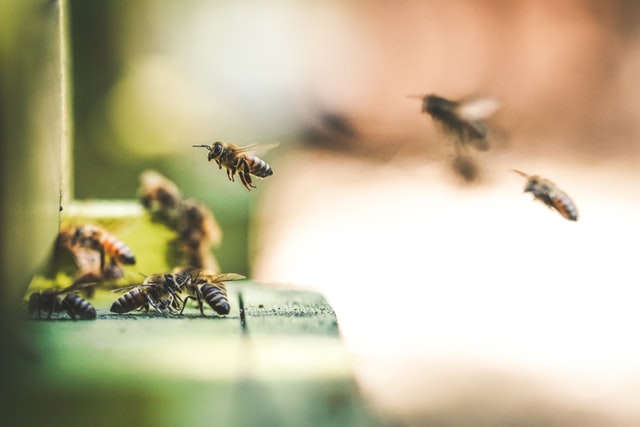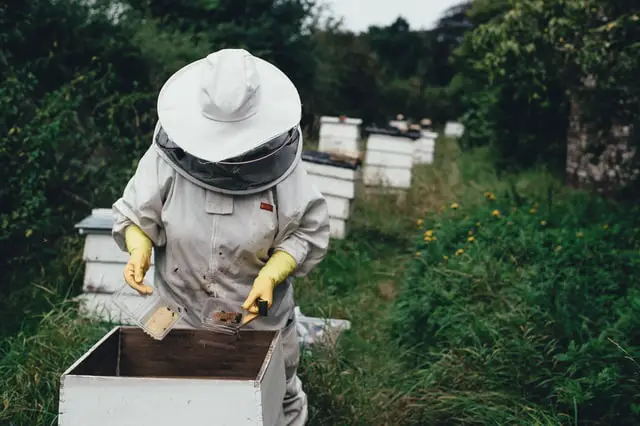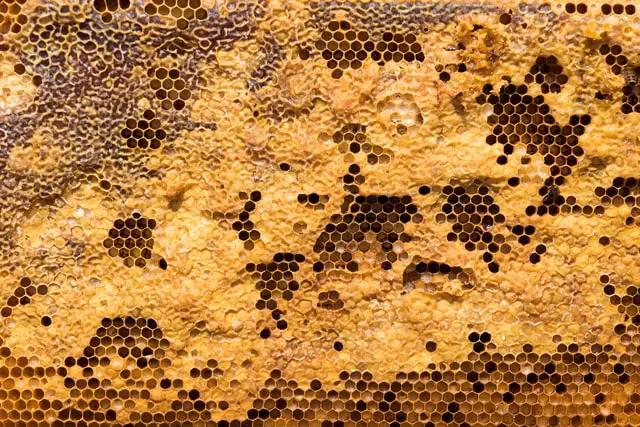Last updated on September 21st, 2023 at 12:32 pm
You have probably heard the phrase ‘busy as a bee’ and this comes directly from the intricate and fast-paced lives of a bee colony.
The inner workings of a bee hive are key to bee survival and it can make or break a colony.
Conditions need to be just right to support the entire colony, encourage steady reproduction of the queen bee and promote good bee hygiene.
Location
The location of a beehive is vital to the success of the hive and the colony. Each year there is a swarming season, typically between March and June. During this time, approximately half a colony of bees will leave their hive looking for a new hive site.
When a bee finds a good spot, it will report its findings to the swarm by performing what is known as a ‘waggle dance‘. This involves intricate turns, abdominal quivering, and figure-of-eight movements.
The waggle dance is how bees give directions and communicate with the rest of their colony. Other bees will go to the signaled location to check if it is suitable.
The bees who like this proposed site will also start to dance, almost like a strange voting system. The site that attracts the most bees will be the chosen site for the new hive.
There are several important factors when choosing a suitable location.
Size: the size of the new hive site is important as it has to be large enough to accommodate the current swarm and any future bees produced by the queen.
Whether the new hive site is a man-made beehive or a hollow within a tree, the location has to be a good size to support construction and expansion for the colony to be successful.
Food resources: bees look for 3 main sources; pollen, nectar, and propolis. Almond, cherry, willow, and crab apple trees are all great pollen and nectar producers.
When it comes to flowers, bees love roses, lilac, apple blossom, rosemary, lavender, and fuchsias.
Bees produce propolis from tree resin, which is collected from tree sap and leaf buds.
The resin is mixed with wax, honey, and stomach enzymes to produce propolis.
Water: it may seem a simple construct, but there must be a water source near the hive or the colony will not survive. Bees use water for more than just drinking. It is used for food, hive construction, and air conditioning to keep the hive cool.
Protection from the weather: bees will not build their nests in a location that gets a lot of direct sunlight, as the heat will melt the wax and honeycomb, destroying the internal structure of the nest.
The ideal location is raised off the ground and sheltered from direct sunlight and harsh winds.

Hive Construction
The construction and layout of a beehive are vital to the smooth running of the colony. A hive consists of brood cells for rearing eggs, food and resource storage, and the hive entrance.
Man-made beehive boxes already have the outer shell and some internal structure. The worker bees will only need to seal the crevices and establish areas for storage and rearing young.
Natural nests built by the colony look different from man-made beehives. The colony will choose a suitable spot such as a hollow in a tree trunk of the eaves of a building.
They will use propolis to construct the outer shell of the nest, then focus on building the individual hexagonal cells from honeycomb and wax, using propolis to fill the gaps in between each cell.
Both man-made hives and natural nests are constructed in the same fashion. The cells located at the top are used for storing honey. The rows below are used to store pollen, nectar, and water.
The following rows are for female worker eggs and larvae, then drone eggs and larvae in the rows below. The lowest cells are reserved for queen eggs and larvae.
Beehives have a single entrance. This helps to prevent the likelihood of intruders entering the hive and drone bees will swarm around the entrance to protect the colony. A well-constructed hive will last a bee colony several years.

Hive Health
At the entrance and throughout the hive, bees use propolis as a form of protection. Propolis has antimicrobial properties, so bees entering the hive walk over the propolis, which prevents germs from spreading throughout the nest.
The colony uses this same method against predators. It works in a similar way to embalming fluid and prevents decomposing insects from introducing disease to the colony. This is especially useful if the colony are unable to move the intruder out of the hive.
Water is a vital resource in maintaining the health of the hive. Not only is water used for hydration, but it also forms an integral part of climate control within the hive.
Worker bees will collect water and distribute water droplets in strategic locations throughout the hive. They will then fan their wings to circulate the cool air produced by the water. This helps to keep the hive at a stable temperature and prevent overheating.
There are several diseases and parasites that can decimate a bee colony. Nosemosis and acarapisosis are both known to affect honeybees, as are a handful of viruses.
Most diseases are caused by mites or parasites. Amoeba disease is caused by a single-cell mellificae parasite and affects worker bees more severely than drones or queens.
Bee colonies are also at risk from Asian hornets, which are invasive species originating from China. They feed primarily on honeybees and can cause the collapse of an entire colony.
They also introduce bacteria and microbes that native bee species would not normally come into contact with.

Reproduction
Within a beehive, the queen bee is the only bee to reproduce. During the larval stage, the food given to females determines whether they will develop into workers or queens.
Find out what happens if you kill a queen bee?
Worker bees are unable to reproduce and their role within the hive is to store resources, clean the hive, and care for the eggs and larvae.
The queen controls the colony by releasing pheromones. This keeps the colony cohesive and functional. Queens lay two types of eggs; fertilized eggs will produce female larvae and unfertilized eggs will produce male larvae.
The queen takes one mating flight where she will mate with several drones, storing all the sperm she will need during her lifetime to fertilize her eggs.
To ensure genetic diversity within the colony, the new queen will only mate with drones from other colonies.
When male larvae reach adulthood, they are called drones. Their role is to protect the entrance to the hive and to mate with a new queen. Unfortunately, once a male drone has mated with a queen, he will die.
Female larvae will become worker bees if they are fed bee bread and will become a queen if they are fed royal jelly. Bee bread is a mixture of honey and pollen, while royal jelly is a substance secreted from glands in the hypopharynx of worker bees.
For the first couple of days, all larvae receive royal jelly, however, after day 3 any larvae continuing to receive royal jelly will develop into potential queens. Other larvae will be fed bee bread for the remaining few days before they pupate.
Food Storage
The process of storing food begins when worker bees return from flights to collect pollen, nectar, and tree resin. Worker bees will wait at the entrance to collect resources from returning bees.
The workers then carry the various substances to storage cells within the hive. There may be clusters of food stores throughout the hive and during winter it is possible for bees to starve if one food store is used and they are isolated from other food stores within the hive.
Head over to our short read on where do bees go in winter for more on how different species act as winter approaches.
Wax, honey, pollen, nectar, and water are all stored separately as they have different uses for the colony. Some substances are used for food, while others are also used for construction within the hive or for climate control.
Honey is vital as a winter food since there will be no pollen or nectar sources available during winter.
It is important that the colony has food stores within the hive that will last them through winter as they will not be able to collect new resources once the cold weather sets in and the flowers die off.
A healthy colony with lots of workers and several food stores will be able to survive winter. A small colony with only a few food stores will likely starve before spring arrives.





